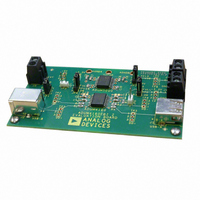EVAL-ADUM4160EBZ Analog Devices Inc, EVAL-ADUM4160EBZ Datasheet - Page 10

EVAL-ADUM4160EBZ
Manufacturer Part Number
EVAL-ADUM4160EBZ
Description
EVALUATION MODULE FOR ADUM4160
Manufacturer
Analog Devices Inc
Series
iCoupler®r
Datasheets
1.ADUM4160BRWZ-RL.pdf
(16 pages)
2.EVAL-ADUM4160EBZ.pdf
(8 pages)
3.EVAL-ADUM4160EBZ.pdf
(14 pages)
Specifications of EVAL-ADUM4160EBZ
Main Purpose
Interface, Digital Isolator
Embedded
No
Utilized Ic / Part
ADuM4160
Primary Attributes
USB Bidirectional Isolation
Secondary Attributes
3.1 V ~ 5.5 V Supply
Silicon Manufacturer
Analog Devices
Application Sub Type
USB Port Isolator
Kit Application Type
Interface
Silicon Core Number
ADuM4160
Lead Free Status / RoHS Status
Lead free / RoHS Compliant
Lead Free Status / RoHS Status
Lead free / RoHS Compliant, Lead free / RoHS Compliant
Other names
Q4508819
ADuM4160
APPLICATION INFORMATION
FUNCTIONAL DESCRIPTION
USB isolation in the D+/D- lines is challenging for several
reasons. First, access to the output enable signals is normally
required to control the transceiver. Some level of intelligence
must be built into the isolator to interpret the data stream and
determine when to enable and disable its up-stream and down
stream output buffers. Second, the signal must be faithfully be
reconstructed on the output side of the coupler while retaining
precise timing and not passing transient states such as invalid
SE0 and SE1 states. In addition, the part must meet the low
power requirements of the Suspend mode.
The iCoupler technology is based on edge detection, and so
lends itself well to the USB application. The flow of data
through the device is accomplished by monitoring the inputs
for activity, and setting the direction for data transfer based on a
transition from the Idle state. Once data directionality is
established, data is transferred until either an End Of Packet
(EOP), or a sufficiently long idle state is encountered. At this
point, the coupler disables its output buffers and monitors its
inputs for the next activity
During the data transfers, the input side of the coupler holds its
output buffers disabled. The output side enables its output
buffers and disables edge detection from the input buffers. This
allows the data to flow in one direction without wrapping back
through the coupler making the iCoupler latch. Timing is based
on the differential input signal transition. Logic is included to
eliminate any artifacts due to different input thresholds of the
differential and single ended buffers. The input state is
transferred across the isolation barrier, as one of three valid
states, J. K, or SE0. The signal is reconstructed at the output side
with a fixed time delay from the input side differential input.
The requirement for low power suspend mode is addressed by
making the Idle state power consumption lower than the
Suspend limit of 2.5mA. The iCoupler has no suspend feature
apart from a low Idle current that meets the required level.
The ADuM4160 is designed to interface with an up-stream
facing Low/Full speed USB port by isolating the D+/D- lines.
An upstream facing port supports only one speed of operation
so the speed related parameters, J/K logic levels and D+/D- slew
rate are set to match the speed of the upstream facing peripheral
port (see Table 10).
A control line on the downstream side of the ADuM4160
activates the Idle state pull-up resistor. This allows the down
stream port to control when the upstream port attaches to the
USB bus. The pin can be tied to the peripheral pull-up, a
control line, or the Peripheral’s power supply depending on
when the initial bus connect is performed.
Rev. Pr F | Page 10 of 14
PRODUCT USAGE
The ADuM4160 is designed to be integrated into a USB
peripheral with an upstream facing USB port as shown in
Figure 4. The key design points are:
Other than, the delayed application of pull-up resistors, the
ADuM4160 is be transparent to USB traffic, and no
modifications to the peripheral design are required to isolate.
The isolator does add propagation delay to the signals
equivalent to a hub and cable so isolates peripherals must be
treated as if there was a built in hub when determining the
maximum number of hubs in a data chain.
POWER SUPPLY OPTIONS
In most USB transceivers, 3.3V is derived from the 5V USB bus
through an LDO regulator. The ADuM4160 includes an
internal LDO regulator on each side to perform this function. It
also allows the regulator to be bypassed if 3.3V is available
directly. This feature is especially useful in peripherals where
there may not be a 5V power rail. Two power input pins are
1) The USB host provides power for the upstream side of
2) The peripheral supply provides power to the
3) The isolator interfaces with the D+/D- lines of the
4) Peripheral devices have a fixed data rate that is set at
5) USB enumeration begins when either the D+ or D-
6) Integrated pull-up and pull-down resistors are internal
the ADuM4160 through the cable.
downstream side of the ADuM4160
peripheral controller, so it behaves like a single port
hub to the peripheral.
design time. The ADuM4160 has configuration pins
SPU and SPD that are set by the user to match this
speed on the upstream and downstream sides of the
coupler.
line is pulled high at the peripheral end of the USB
cable. Control of the timing of this event is provided
by the PIN input on the down stream side of the
coupler.
to the coupler.
Figure 4 TypicaADuM4160l Application
Preliminary Technical Data


















